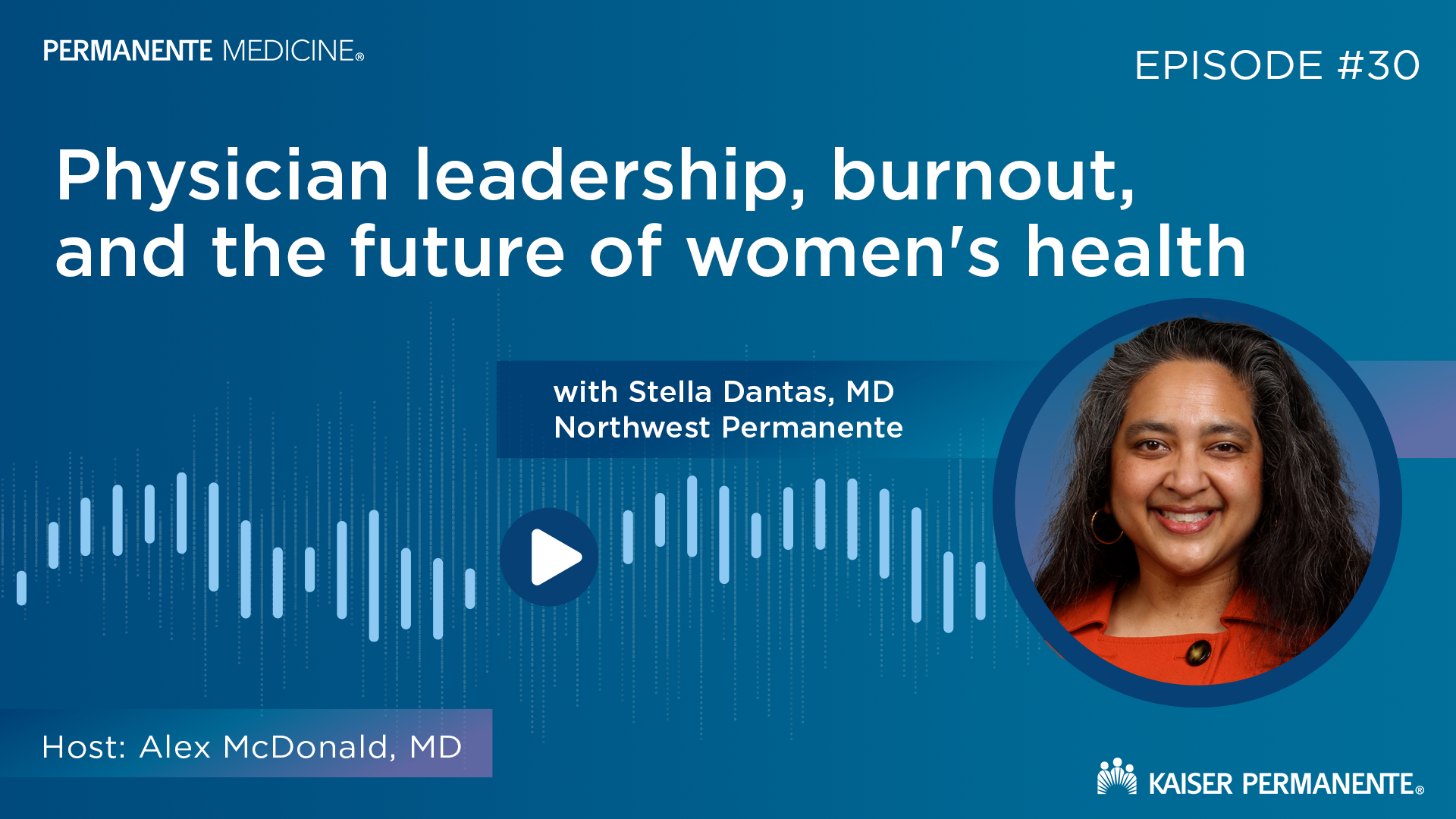Protecting patient health resulting from climate change requires coordinated efforts from physicians, health systems, and communities. Learn how Permanente Medicine is tackling this challenge.

Less desktop, more bedside: Using augmented intelligence to accelerate health care innovation
By Kristine Lee, MD
Nearly 2 out of 3 physicians reported at least one symptom of burnout in a study published last year, establishing a high-water mark of exhaustion and fatigue among doctors. Symptoms of burnout include reduced productivity, increased absenteeism, and physical and mental health issues. Burnout is increasingly driving talented, capable physicians out of health care, as well as chasing away new generations of would-be physicians from medicine.
Related story: “AMA Recognizes Permanente Medical Groups for tackling physician burnout”
Despite these trends, I am optimistic that emerging technologies, including artificial intelligence (AI) and related health care innovations, as well as support programs designed to reduce burnout, provide us the best opportunity yet to improve patient care while effectively addressing the root causes of physician burnout. Focusing on “desktop medicine,” or the amount of time a physician spends in front of a computer during and after patient visits performing numerous administrative tasks, is fundamental to improving wellness.
AI’s future is augmented, not artificial
People are rightly concerned about the use of AI in health care, particularly in these early days with no guardrails in place to regulate its use. There also is evidence that the algorithms powering AI have racial bias built into them, and that AI can at times assess situations incorrectly and recommend the wrong course of action.
At Kaiser Permanente, what we call “augmented intelligence” is an important preliminary step to unlocking the ultimate potential of AI to empower physicians and alleviate burnout. Our approach to AI places people, patients, communities, and clinicians at its center, not rules for performing a computation. Think of it as another decision support tool physicians can use to augment their capability, improve care quality, and make their jobs a little easier and more enjoyable.
Related Newsmaker: “Permanente Federation co-CEOs talk health care innovation, quality and physician leadership”
We are already testing computer vision to better examine radiology scans and images. While traditional tools can detect and flag visible cancers, Kaiser Permanente’s AI can analyze mammograms and correctly identify high-risk concerns before cancer cells develop. For example, in looking at tens of thousands of images, Kaiser Permanente Northern California investigators determined that computer vision algorithms could identify high-risk features even within screening mammograms deemed as normal by radiologists. When paired with workflows, such algorithms could increase the identification of patients who may be at risk for breast cancer from 20% using traditional approaches to 60% or more.
AI is also used in Kaiser Permanente Northern California’s predictive analytics-driven program called Advance Alert Monitor to identify hospital patients who may be at risk of serious decline and may need intervention. Use of the AI-driven system has prevented more than 500 deaths a year while reducing high-risk admissions by 10% in Northern California alone.
AI was used to identify 54,000 patients with valvular heart disease from nearly a million echocardiography reports. This process, which would have taken years to complete manually, was completed in a matter of minutes.
Using AI to streamline workflows
Doctors increasingly bring up the relationship between burnout and patient portals. A patient portal is a secure online website that gives patients convenient, 24-hour access to their personal health information. Physicians today receive 57% more patient portal messages than they did prior to the pandemic, increasing workload and contributing to physician burnout.
Related content: “Physicians leading through change: AI, mistrust, burnout and more”
To increase efficiency and reduce related burnout, we are leveraging data and technology to reduce asynchronous workflow — the practice of working on a team that does not require all members to be online simultaneously — such as managing the email inbox by rerouting some emails to other team members when appropriate. The goal is to drive continuous process improvement so that work is performed by the proper clinicians and staff, with everyone practicing at the top of their license.
That’s why we are working on natural language processing tools that can sort messages into categories physicians can prioritize with either an urgent response or delegate to another member of the care team.
In Northern California, we are also employing ambient listening AI to help physicians write their clinic visit notes, whether visiting with a patient in-person or virtually, across any medical specialty. This enables more face-to-face time with patients and cuts down on “pajama time” – time spent on administrative tasks after hours.
In the end, AI must be adopted within a “remove or replace” framework. If an AI process is added, it must either replace a task or make it more efficient.
Harnessing AI to transform health care
Of course, all use of AI must be closely monitored, regulated, vetted, and tested. Physicians are the ones treating patients, not AI, and they must remain 100% responsible for their clinical decision-making.
We are only at the beginning of appreciating how AI can help doctors and the entire care team.
Ultimately, the most consequential and important benefit of augmented intelligence is its capacity to help physicians spend less time at their desks and more time seeing, treating, and healing patients — the meaningful and immense responsibility and privilege that called many to medicine in the first place.
Kristine Lee, MD, is associate executive director of Virtual Medicine and Technology at The Permanente Medical Group.


